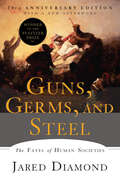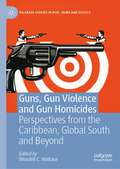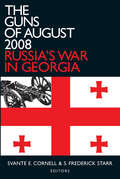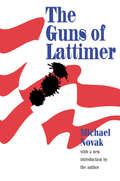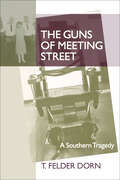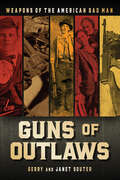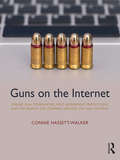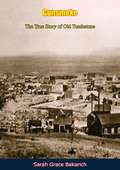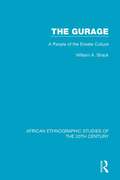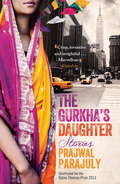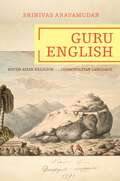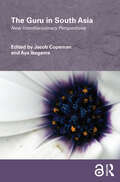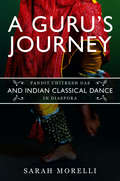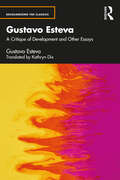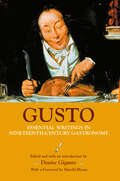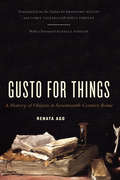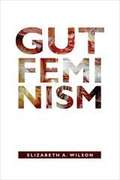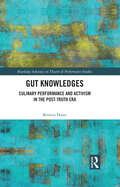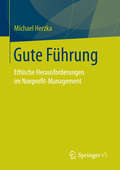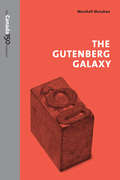- Table View
- List View
Guns, Germs, and Steel: The Fates Of Human Societies
by Jared DiamondIn this book, Jared Diamond convincingly argues that geographical and environmental factors shaped the modern world. Societies that had had a head start in food production advanced beyond the hunter-gatherer stage, and then developed religion --as well as nasty germs and potent weapons of war --and adventured on sea and land to conquer and decimate preliterate cultures. A major advance in our understanding of human societies, Guns, Germs, and Steel chronicles the way that the modern world came to be and stunningly dismantles racially based theories of human history. <P><P> Winner of the Pulitzer Prize, the Phi Beta Kappa Award in Science, the Rhone-Poulenc Prize, and the Commonwealth club of California's Gold Medal.
Guns, Germs & Steel: The Fate of Human Societies
by Riley QuinnIn his 1997 work Guns, Germs and Steel, Jared Diamond marshals evidence from five continents and across 13,000 years of human history in an attempt to answer the question of why that history unfolded so differently in various parts of the globe. His results offer new explanations for why the unequal divisions of power and wealth so familiar to us today came into existence – and have persisted. Balancing materials drawn from a vast range of sources, addressing core problems that have fascinated historians, anthropologists, biologists and geographers alike – and blending his analysis to create a compelling narrative that became an international best-seller and reached a broad general market – required a mastery of the critical thinking skill of reasoning that few other scholars can rival. Diamond’s reasoning skills allow him to persuade his readers of the value of his interdisciplinary approach and produce well-structured arguments that keep them turning pages even as he refocuses his analysis from one disparate example to another. Diamond adds to that a spectacular ability to grasp the meaning of the available evidence produced by scholars in those widely different disciplines – making Guns, Germs and Steel equally valuable as an exercise in high-level interpretation.
Guns, Gun Violence and Gun Homicides: Perspectives from the Caribbean, Global South and Beyond (Palgrave Studies in Risk, Crime and Society)
by Wendell C. WallaceThis book provides in-depth coverage of guns, gun violence and gun homicides from a variety of perspectives, including, but not limited to, gender, suicide, peaceology and police (in)action. Reflecting changes in contemporary perceptions as well as desires for scholarship emanating from under-researched areas of the globe, this book addresses the pervasive issue of guns, gun violence and gun homicides. Authored by a wide range of Social Science experts, and premised on the notions of epistemological diversity, inclusivity and knowledge production in the Global South, this book provides comprehensive coverage on the nebulous concern of guns and their destructive force using differing approaches to the same problem, with a focus on prevention/reduction of gun violence. Readers may find the chapters contained in this book to be fascinating, provocative, informative, clearly presented and solution oriented. This book is of special interest to students, criminologists, policymakers, criminal justice system officials and laypersons. It is invaluable to policymakers at differing levels of government who provide advice on the social issue of guns and gun violence in their respective jurisdictions.
The Guns of August 2008: Russia's War in Georgia (Studies of Central Asia and the Caucasus)
by Svante E. Cornell S. Frederick StarrIn the summer of 2008, a conflict that appeared to have begun in the breakaway Georgian territory of South Ossetia rapidly escalated to become the most significant crisis in European security in a decade. The implications of the Russian-Georgian war will be understood differently depending on one's narrative of what transpired and perspective on the broader context. This book is designed to present the facts about the events of August 2008 along with comprehensive coverage of the background to those events. It brings together a wealth of expertise on the South Caucasus and Russian foreign policy, with contributions by Russian, Georgian, European, and American experts on the region.
The Guns of August 2008: Russia's War in Georgia (Studies of Central Asia and the Caucasus)
by Svante E. Cornell S. Frederick StarrIn the summer of 2008, a conflict that appeared to have begun in the breakaway Georgian territory of South Ossetia rapidly escalated to become the most significant crisis in European security in a decade. The implications of the Russian-Georgian war will be understood differently depending on one's narrative of what transpired and perspective on the broader context. This book is designed to present the facts about the events of August 2008 along with comprehensive coverage of the background to those events. It brings together a wealth of expertise on the South Caucasus and Russian foreign policy, with contributions by Russian, Georgian, European, and American experts on the region.
The Guns of Lattimer
by Michael NovakOn September 10, 1897, in the hamlet of Lattimer mines, Pennsylvania, an armed posse took aim and fired into a crowd of oncoming mine workers, who were marching in their corner of the coal-mining region to call their fellow miners out on strike. The marchers Poles, Slovaks, Hungarians, most of whom could not yet speak English were themselves armed only with an American flag and a timid, budding confidence in their new found rights as free men in their newly adopted country. The mine operators took another view of these rights and of the strange, alien men who claimed them. When the posse was done firing, nineteen of the demonstrators were dead and thirty-nine were seriously wounded. Some six months later a jury of their peers was to exonerate the deputies of any wrong-doing.This long-forgotten incident is here movingly retold by Michael Novak, himself the son of Slovak immigrants and one of our most gifted writers and social observers. In his hands, the so-called "Lattimer Massacre" becomes not only a powerful story in its own right (and an invaluable key to the history of the growth of the united mine Workers), but an allegory of that peculiarly American experience undergone over and over again throughout the land, and down to this very day; the experience of new immigrants, still miserable with poverty and bewilderment and suffering the trauma of culture shock, being confronted by the hostility and blind contempt of the "real" Americans.In Michael Novak's uniquely vivid account, the incident at Lattimer is seen as a tragedy brought on not so much by inhumanity as by the profound failure of majority WASP society to understand the needs and responses of "foreigners." The Guns of Lattimer is a gripping book that tells Americans, old and new, a great deal about themselves and the society they live in.
The Guns of Meeting Street: A Southern Tragedy
by T. Felder DornAn engrossing investigation into the true crime story of a sixteen-year family feud that ended in murder in early twentieth-century South Carolina.As compelling as fiction, The Guns of Meeting Street reconstructs a series of murders from the early 1940s that rocked rural Edgefield County, South Carolina. Featuring a cast of unlikely antagonists—a prominent store owner, an elementary school teacher, and a law enforcement officer—the acts of revenge resulted in five murders and a trio of executions, including that of the first woman to be electrocuted in South Carolina.Through interviews with members of the two families involved, T. Felder Dorn probes the longstanding feud between the Logues and the Timmermans to uncover this chilling plot of resentment, revenge, and violence. Dorn’s careful research weaves together the oral history of family members affected by the shooting with court transcripts, prisoner confessions, and coroners’ reports to produce a truly gripping account of the events.Although most of the deaths took place between 1940 and 1943, the roots of this tragedy can be traced back to killings that occurred in the Meeting Street community in the 1920s. The story climaxes on January 15, 1943, with the execution, within a single hour, of Sue Stidham Logue, George Logue, and Clarence Bagwell for the murder of Davis Timmerman. Dorn’s saga concludes with the 1960 parole and rehabilitation of Joe Frank Logue Jr., the only one of Timmerman’s killers to escape capital punishment.Not for the faint of heart, The Guns of Meeting Street details the circumstances and motivations for the killings, the complexities of the court cases, and the involvement in the proceedings of South Carolina governors Richard Manning Jefferies, Olin D. Johnston, and J. Strom Thurmond.“If you have any interest in history or true crime, The Guns of Meeting Street is a winner.” —Spartanburg Herald Journal“Dorn’s rigorously researched book unfolds in a clear, straightforward style that renders the events all the more disturbing.” —The State“Dorn’s extremely impressive book has all the elements—is fascinating in its entirety. And for every reader who loves a good mystery, The Guns of Meeting Street is available to intrigue, inform, incite and excite. It’ll never get a chance to gather dust on any bookshelf.” —Union (N.J.) Leader
Guns of Outlaws: Weapons of the American Bad Man
by Gerry Souter Janet Souter“Chronicles the misdeeds of many of America’s worst miscreants, with special emphasis on the tools of the outlaw trade.” —American RiflemanFrom colonial-era rifles carried on the “Owlhoot Trail” to John Dillinger’s Colt pistols, the history of the American outlaw is told in guns—weapons that became each man’s personal signature. Authors Gerry and Janet Souter peer into these criminals’ choices of derringers, revolvers, shotguns, rifles, machine guns, and curious hybrids, giving us a glimpse into the minds behind the trigger fingers. With over 200 illustrations, Guns of Outlaws gives a unique look at the lives and the hardware of the most infamous outlaws in American history, and of the law enforcement officers who hunted them.As settlers moved further west, away from authority and soft city life into the Great Plains, the push for survival through the endless prairies and jagged isolating mountain ranges bred ruthless men. Most outlaws were technology freaks who seized upon the latest weapon innovations developed in the industrious East to provide an edge in the life-and-death cosmos of the Wild West. By the late 1930s and early 1940s, outlaws on horseback had given way to marauding bank robbers. Using fast cars and faster guns, they became folk heroes of the Great Depression, even as the law was hard on their tails.“Historians Gerry and Janet Souter take the reader back to a time between 1840 and 1940 when . . . outlaws and man hunters lived bold and died hard . . . [The] book show[s] actual tools of the trade wielded during a violent century, bound up in a mix of hard truths and mythology.” —Ammoland.com
Guns on the Internet: Online Gun Communities, First Amendment Protections, and the Search for Common Ground on Gun Control
by Connie Hassett-WalkerGun rights and control are well-trodden subjects, with prior work supporting the right of citizens to own firearms, discussing the failure of gun control efforts, or warning about or exhorting citizen gun ownership, among other things. Although social media in their many forms have only come to dominate modern U.S. life during the past decade, there has been little academic exploration of gun owner communities on the Internet and social media. How do gun owners use social media? How do they meet other gun owners online? What do they talk about as relates to guns? With a massive and well-organized collection of support material, Guns on the Internet faces these questions with an unbiased approach that seeks a foundation for mutual understanding.
Gunsmoke: The True Story of Old Tombstone
by Sarah Grace BakarichThe history of Tombstone, Arizona and the surrounding area, as recalled by Sarah Grace Bakarich.This small volume tells the story of the sensational aspects of the town of Tombstone in the 1880’s. It focuses on Wyatt Earp and his brothers, the Clantons, and other gunmen and characters of the town. This book has become a minor classic for collectors of stories of the Old West.
The Gurage: A People of the Ensete Culture
by William A. ShackOriginally published in 1966 this study gives a detailed account of all aspects of Gurage life. An introductory chapter on South-West Ethiopia and the history of the area is followed by descriptions of Gurage settlements, ensete (banana-like plants) cultivation, kinship and marriage, the political system and religious organization. The author's fieldwork and discussions with many resident and migrant Gurage in Addis Ababa enabled him to provide a valuable account of a hitherto little known people and ethnographic area.
The Gurkha's Daughter: shortlisted for the Dylan Thomas prize
by Prajwal ParajulyA pioneering collection describing and dramatizing the Nepalese diaspora - the displacement and exile of the Nepali-speaking world*SHORTLISTED FOR THE DYLAN THOMAS PRIZE*A disfigured servant girl plans to flee Nepal; a Kalimpong shopkeeper faces an impossible dilemma; a Hindu religious festival in Darjeeling brings with it a sacrifice; a Nepali-Bhutanese refugee pins her hopes on the West; a Gurkha's daughter tries to comprehend her father's complaints; two young Nepali-speaking immigrants meet in Manhattan. These are just some of the stories of the people whose culture and language is Nepalese but who are dispersed to India, Bhutan and beyond. From every perspective and on every page, Prajwal Parajuly blends rich colour and vernacular to paint an eye-opening picture of a unique world and its people.
The Gurkha's Daughter: shortlisted for the Dylan Thomas prize
by Prajwal ParajulyA pioneering collection describing and dramatizing the Nepalese diaspora - the displacement and exile of the Nepali-speaking world*SHORTLISTED FOR THE DYLAN THOMAS PRIZE*A disfigured servant girl plans to flee Nepal; a Kalimpong shopkeeper faces an impossible dilemma; a Hindu religious festival in Darjeeling brings with it a sacrifice; a Nepali-Bhutanese refugee pins her hopes on the West; a Gurkha's daughter tries to comprehend her father's complaints; two young Nepali-speaking immigrants meet in Manhattan. These are just some of the stories of the people whose culture and language is Nepalese but who are dispersed to India, Bhutan and beyond. From every perspective and on every page, Prajwal Parajuly blends rich colour and vernacular to paint an eye-opening picture of a unique world and its people.
Guru English: South Asian Religion in a Cosmopolitan Language (Translation/Transnation #12)
by Srinivas AravamudanGuru English is a bold reconceptualization of the scope and meaning of cosmopolitanism, examining the language of South Asian religiosity as it has flourished both inside and outside of its original context for the past two hundred years. The book surveys a specific set of religious vocabularies from South Asia that, Aravamudan argues, launches a different kind of cosmopolitanism into global use. Using "Guru English" as a tagline for the globalizing idiom that has grown up around these religions, Aravamudan traces the diffusion and transformation of South Asian religious discourses as they shuttled between East and West through English-language use. The book demonstrates that cosmopolitanism is not just a secular Western "discourse that results from a disenchantment with religion, but something that can also be refashioned from South Asian religion when these materials are put into dialogue with contemporary social move-ments and literary texts. Aravamudan looks at "religious forms of neoclassicism, nationalism, Romanticism, postmodernism, and nuclear millenarianism, bringing together figures such as Swami Vivekananda, Sri Aurobindo, Mahatma Gandhi, and Deepak Chopra with Rudyard Kipling, James Joyce, Robert Oppenheimer, and Salman Rushdie. Guru English analyzes writers and gurus, literary texts and religious movements, and the political uses of religion alongside the literary expressions of religious teachers, showing the cosmopolitan interconnections between the Indian subcontinent, the British Empire, and the American New Age.
The Guru in South Asia: New Interdisciplinary Perspectives (Routledge/Edinburgh South Asian Studies Series)
by Aya Ikegame Jacob CopemanThis book provides a set of fresh and compelling interdisciplinary approaches to the enduring phenomenon of the guru in South Asia. Moving across different gurus and kinds of gurus, and between past and present, the chapters call attention to the extraordinary scope and richness of the social lives and roles of South Asian gurus. Prevailing scholarship has rightly considered the guru to be a source of religious and philosophical knowledge and mystical bodily practices. This book goes further and considers the social engagements and entanglements of these spiritual leaders, not just on their own (narrowly denominational) terms, but in terms of their diverse, complex, rapidly evolving engagements with ‘society’ broadly conceived. The book explores and illuminates the significance of female gurus, gurus from the perspective of Islam, imbrications of guru-ship and slavery in pre-modern India, connections between gurus and power, governance and economic liberalization in modern and contemporary India, vexed questions of sexuality and guru-ship, gurus’ charitable endeavours, the cosmopolitanism of gurus in contexts of spiritual tourism, and the mediation of gurus via technologies of electronic communication. Bringing together internationally renowned scholars from religious studies, political science, history, sociology and anthropology, The Guru in South Asia provides exciting and original new insights into South Asian guru-ship.
A Guru’s Journey: Pandit Chitresh Das and Indian Classical Dance in Diaspora (Music in American Life)
by Sarah MorelliAn important modern exponent of Asian dance, Pandit Chitresh Das brought kathak to the United States in 1970. The North Indian classical dance has since become an important art form within the greater Indian diaspora. Yet its adoption outside of India raises questions about what happens to artistic practices when we separate them from their broader cultural contexts. A Guru's Journey provides an ethnographic study of the dance form in the San Francisco Bay Area community formed by Das. Sarah Morelli, a kathak dancer and one of Das's former students, investigates issues in teaching, learning, and performance that developed around Das during his time in the United States. In modifying kathak's form and teaching for Western students, Das negotiates questions of Indianness and non-Indianness, gender, identity, and race. Morelli lays out these issues for readers with the goal of deepening their knowledge of kathak aesthetics, technique, and theory. She also shares the intricacies of footwork, facial expression in storytelling, and other aspects of kathak while tying them to the cultural issues that inform the dance.
Gustavo Esteva: A Critique of Development and other essays (Decolonizing the Classics)
by Gustavo EstevaIn his reflections on decolonization and post-development, Gustavo Esteva forged a unique synthesis of critical theory and political economy. This book presents more than half a century of "reflection in action" in the form of essays, books, and interventions in national and international forums and newspaper articles—most published here for the very first time. It showcases Esteva’s evolving thought on economic theory, social change, revolutionary subjectivity, transition, development, the challenges of a new era and personal and communal autonomy, all associated with the challenges and advances in the construction of a new society. Through this translation, Esteva’s writings engage with many of the important cultural and political debates of the present day and retain their power both to provoke and move the reader. Readers will see a thinker at work, formulating local, grassroots alternatives as they are emerging in Mexico and Latin America, with a keen sensibility to what happens in other regions of the world. Gustavo Esteva: A Critique of Development and Other Essays offers a lucid insight into the climatic and sociopolitical collapses we face and will be of interest to students and scholars of critical theory, post-colonial and de-colonial studies, and post-development studies.
Gusto: Essential Writings in Nineteenth-Century Gastronomy
by Denise GiganteFirst published in 2006. Routledge is an imprint of Taylor & Francis, an informa company.
Gusto for Things: A History of Objects in Seventeenth-Century Rome
by Renata AgoWe live in a material worldOCoour homes are filled with things, from electronics to curios and hand-me-downs, that disclose as much about us and our aspirations as they do about current trends. But we are not the first: the early modern period was a time of expanding consumption, when objects began to play an important role in defining gender as well as social status. "Gusto for Things" reconstructs the material lives of seventeenth-century Romans, exploring new ways of thinking about the meaning of "things" as a historical phenomenon. aThrough creative use of account books, inventories, wills, and other records, Renata Ago examines early modern attitudes toward possessions, asking what people did with their things, why they wrote about them, and how they passed objects on to their heirs. While some inhabitants of Rome were connoisseurs of the paintings, books, and curiosities that made the city famous, Ago shows that men and women of lesser means also filled their homes with a more modest array of goods. She also discovers the genealogies of certain categories of thingsOCofor instance, books went from being classed as luxury goods to a category all their ownOCoand considers what that reveals about the early modern era. An animated investigation into the relationship between people and the things they buy, "Gusto for Things" paints an illuminating portrait of the meaning of objects in preindustrial Europe. "
Gut Anthro: An Experiment in Thinking with Microbes
by Amber BenezraA fascinating ethnography of microbes that opens up new spaces for anthropological inquiry The trillions of microbes in and on our bodies are determined by not only biology but also our social connections. Gut Anthro tells the fascinating story of how a sociocultural anthropologist developed a collaborative &“anthropology of microbes&” with a human microbial ecologist to address global health crises across disciplines. It asks: what would it mean for anthropology to act with science? Based partly at a preeminent U.S. lab studying the human microbiome, the Center for Genome Sciences at Washington University, and partly at a field site in Bangladesh studying infant malnutrition, it examines how microbes travel between human guts in the &“field&” and in microbiome laboratories, influencing definitions of health and disease, and how the microbiome can change our views on evolution, agency, and life.As lab scientists studied the interrelationships between gut microbes and malnutrition in resource-poor countries, Amber Benezra explored ways to reconcile the scale and speed differences between the lab, the intimate biosocial practices of Bangladeshi mothers and their children, and the looming structural violence of poverty. In vital ways, Gut Anthro is about what it means to collaborate—with mothers, local field researchers in Bangladesh, massive philanthropic global health organizations, with the microbiome scientists, and, of course, with microbes. It follows microbes through various enactments in scientific research—microbes as kin, as data, and as race. Revealing how racial categories are used in microbiome research, Benezra argues that microbial differences need transdisciplinary collaboration to address racial health disparities without reifying race as a straightforward biological or social designation.Gut Anthro is a tour de force of science studies and medical anthropology as well as an intensely personal and deeply theoretical accounting of what it means to do anthropology today. Cover alt text:Black background overlaid with a pink organic path suggestive of a human digestive system. Title appears within the guts as if being processed.
Gut Feminism
by Elizabeth A. WilsonIn Gut Feminism Elizabeth A. Wilson urges feminists to rethink their resistance to biological and pharmaceutical data. Turning her attention to the gut and depression, she asks what conceptual and methodological innovations become possible when feminist theory isn't so instinctively antibiological. She examines research on anti-depressants, placebos, transference, phantasy, eating disorders and suicidality with two goals in mind: to show how pharmaceutical data can be useful for feminist theory, and to address the necessary role of aggression in feminist politics. Gut Feminism's provocative challenge to feminist theory is that it would be more powerful if it could attend to biological data and tolerate its own capacity for harm.
Gut Knowledges: Culinary Performance and Activism in the Post-Truth Era (Routledge Advances in Theatre & Performance Studies)
by Kristin HuntThis book examines historical and contemporary activist alimentary performance with an eye toward, or perhaps a taste for, what these performance modes can reveal about changing relationships between the senses, truth, justice, and ethical action amid the post-truth era’s destabilization of shared notions of truth. This inquiry emerges in response to an urgent need to understand how multisensory models of knowledge, truth, and justice can be ethically employed to nurture a more just society. Alongside this goal is a drive to understand the ways in which these modes of performance are being co-opted by authoritarians, white supremacists, anti-science activists, and others to shore up injustice, promote misinformation, and anxiously guard existing systems of power and privilege. From white supremacist milk-drinking performances to liberatory uses of culinary performance as pedagogy, Kristin Hunt analyzes both disturbing and inspiring alimentary events to understand how performers, cooks, scholars, artists, and activists can effectively cultivate models of alimentary performance that center plenitude, joy, and justice while pushing back against models rooted in anxiety, diminishment, and cruelty. The text should be of interest for students in performance studies, contemporary theatre, and theatre history as well as courses in food studies and popular culture.
Gute Führung: Ethische Herausforderungen im Nonprofit-Management
by Michael HerzkaIm Spannungsfeld von Ökonomie und Ethik müssen Führungskräfte vielfältigen Erwartungen gerecht werden. Organisationen im Sozial- Bildungs- und Gesundheitswesen erfüllen einen gemeinwohlorientierten und gemeinschaftsbildenden Auftrag, sie begleiten, unterstützen und fördern Menschen in schwierigen Lebenssituationen. Gleichzeitig sollen sie nach betriebswirtschaftlichen Grundsätzen geführt werden. Daraus ergeben sich ethische Fragen, die sich im Management und in der Führung von Mitarbeitenden manifestieren. Fairness, Transparenz und Vertrauen sind unabdingbar. Es wird zunehmend erforderlich, im doppelten Sinne ökonomisch und moralisch ‚gutes‘ Führungshandeln zu reflektieren und neu zu bestimmen. Der Autor zeigt praxisnah, wie das vorhandene professionsethische Instrumentarium im Sinne einer angewandten Führungsethik weiterentwickelt werden kann.
Gute Pflege im transkulturellen Vergleich: Eine Studie in der stationären Altenpflege unter Betrachtung immaterieller Werte (Forum Gesundheitsmanagement)
by Bouchra AchoumrarVor dem Hintergrund eines vielfältigen soziokulturellen Umfeldes des Gesundheits- und Pflegewesens gewinnt die Versorgungsqualität im transkulturellen Kontext kontinuierlich an Bedeutung für die professionelle Pflegepraxis und pflegewissenschaftliche Forschung. Nicht zuletzt aufgrund der sozialpolitischen und ökonomischen Vorgaben wird in den Handlungsfeldern der pflegerischen Praxis die Sicherstellung hoher Versorgungsqualität unter Berücksichtigung der Bedürfnisse sämtlicher potenzieller Anspruchsgruppen angestrebt. Zugleich kommt in Anbetracht der knappen Ressourcen in der Altenpflege sämtlichen materiellen und immateriellen Faktoren eine wichtige Relevanz für eine optimale Erreichung qualitativer sowie wirtschaftlicher Ziele zu. Das vorliegende Buch trägt zu einem vertieften Verständnis dessen bei, welche qualitativen Merkmale, Anforderungen und Handlungsweisen einer guten Pflege im transkulturellen Kontext im Setting stationärer Altenpflege seitens Pflegebedürftiger und beruflicher Akteurinnen und Akteure zugeschrieben werden. Neben der Beantwortung pflegewissenschaftlicher Fragestellungen wird unter Bezugnahme auf betriebswirtschaftliche Zusammenhänge ein Beitrag zur empirischen Fundierung und konzeptionellen Weiterentwicklung sogenannter „immaterieller Werte“ in der stationären Altenpflege geleistet.
The Gutenberg Galaxy
by Marshall McluhanThe Gutenberg Galaxy catapulted Marshall McLuhan to fame as a media theorist and, in time, a new media prognosticator. Fifty years after its initial publication, this landmark text is more significant than ever before. Readers will be amazed by McLuhan’s prescience, unmatched by anyone since, predicting as he did the dramatic technological innovations that have fundamentally changed how we communicate. The Gutenberg Galaxy foresaw the networked, compressed ‘global village’ that would emerge in the late-twentieth and twenty-first centuries — despite having been written when black-and-white television was ubiquitous. This new edition of The Gutenberg Galaxy celebrates both the centennial of McLuhan’s birth and the fifty-year anniversary of the book’s publication. A new interior design updates The Gutenberg Galaxy for twenty-first-century readers, while honouring the innovative, avant-garde spirit of the original. This edition also includes new introductory essays that illuminate McLuhan’s lasting effect on a variety of scholarly fields and popular culture. A must-read for those who inhabit today’s global village, The Gutenberg Galaxy is an indispensable road map for our evolving communication landscape.
